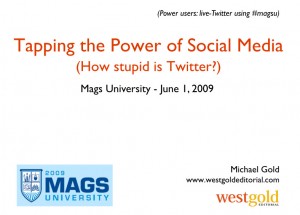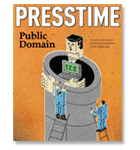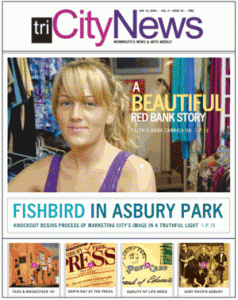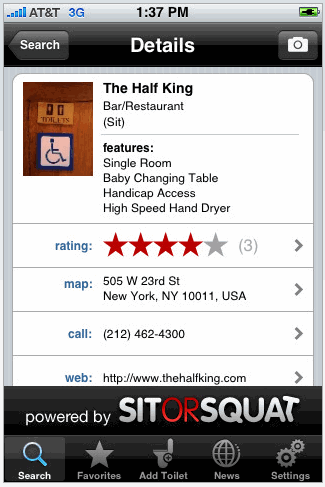ContentWise Blog
By Michael Gold on June 4, 2009
 How should publishers be using microblogs, social networks, wikis, and similar social media tools?
How should publishers be using microblogs, social networks, wikis, and similar social media tools?
I explored that question during a talk at the Mags University conference in Toronto on June 1, 2009. Here are copies of the presentation slides from that session.
Download PDF: Tapping the Power of Social Media (MagsU 2009) 
Posted in Conferences & Classes, Resources, Social Media
By Susan West & Michael Gold on May 27, 2009
 Presstime, the magazine of the Newspaper Association of America, has just published its last issue in print. Beginning in June, Presstime will cover its industry—including the painfully relevant story of how hard it is for publications to survive as hard-copy products—in a digital format only, on the association’s Web site. The New York Times has details.
Presstime, the magazine of the Newspaper Association of America, has just published its last issue in print. Beginning in June, Presstime will cover its industry—including the painfully relevant story of how hard it is for publications to survive as hard-copy products—in a digital format only, on the association’s Web site. The New York Times has details.
While the perceived value of newspapers continues to swoon, the
magazine company Future US believes there’s a substantial pool of
potential readers out there who value pricey guitars—and cars, watches, wine, and “the deluxe life,” in general. The company has
just launched Guitar Aficionado.
 This looks like a smart business move. Coverage of celebrities, investments, high-end lifestyle, and big-ticket travel is probably a magnet for advertising.
This looks like a smart business move. Coverage of celebrities, investments, high-end lifestyle, and big-ticket travel is probably a magnet for advertising.
We take any launch these days as a hopeful sign. And we wish Guitar Aficionado well. Still, we can’t help wishing there were room in this economy not only for a magazine that serves up guitar porn and luxury but also for one that serves the people who put out the nation’s newspapers.
What do you think?
Posted in Advertising, Magazines, Newspapers
By Susan West & Michael Gold on May 15, 2009
 Just catching up on a little Grim Reaper bookkeeping… We hereby add Condé Nast's Portfolio to our list of deceased magazines.
Just catching up on a little Grim Reaper bookkeeping… We hereby add Condé Nast's Portfolio to our list of deceased magazines.
The closing of the two-year-old business glossy and its Web site was announced late last month. Portfolio was the victim of the same severe advertising downturn that has been threatening the entire industry—as well as, perhaps, a touch of mega-media-company hubris. David Carr of the New York Times reported:
Most of the $100 million pledged toward the start-up is gone, sunk into
the very expensive printing, paper, marketing and editorial costs that
go with creating a magazine, especially one published by Condé Nast.
 Carr also noted that Portfolio apparently kept to its extravagant ways until near the very end. To dress up a November 2008 story about JP Morgan Chase entitled "The $58 Trillion Elephant in the Room," the magazine hired a real elephant for the photo shoot. Cost: $30,000.
Carr also noted that Portfolio apparently kept to its extravagant ways until near the very end. To dress up a November 2008 story about JP Morgan Chase entitled "The $58 Trillion Elephant in the Room," the magazine hired a real elephant for the photo shoot. Cost: $30,000.
Jon Fine at BusinessWeek.com posted a thoughtful postmortem.
Posted in Advertising, Magazines
By Susan West & Michael Gold on April 23, 2009
Our friends who run MagsU, one of the best magazine conferences in Canada, are offering some tempting discounts for folks who register by May 1—anywhere from 20 to 50 percent off. At those rates, magazine publishers might actually be able to send some people to the conference.
I hope so, because I (Michael) will be making two presentations there on June 1, both in the digital realm:
- Nine Steps to a Successful Website Redesign. Believe it or not, site redesigns don't have to be interminable, gut-wrenching ordeals that fail to deliver noticeable improvements. But they do need to be carefully planned. This is not about visual design. It's about how the right processes and, dare I say, political awareness can lead to a bang-up new site with less stress.
- Tapping the Power of Social Media. If your confused about crowd-sourcing, fuzzy on Facebook, and wondering what widgets have to with magazines, come to Toronto and we'll do some de-mystifying. I'll show examples, demonstrate a few tools, and recommend strategies to consider in this realm of "social publishing."
For more info, see the conference's full line-up of sessions.
Posted in Conferences & Classes, Magazines
By Susan West & Michael Gold on April 13, 2009
 Heads up: Wednesday is the last day to get a 10 percent early-bird discount on tuition to this summer's Stanford Professional Publishing Course.
Heads up: Wednesday is the last day to get a 10 percent early-bird discount on tuition to this summer's Stanford Professional Publishing Course.
We enjoy teaching at this intensive program every year–the sessions, the faculty, and the participants are always enlightening and often inspiring. Being on the stunning, sun-washed Stanford campus for a week isn't bad, either.
This year, appropriately, the course is emphasizing the re-invention of media in a digital world. We hope you can join us.
Posted in Books, Conferences & Classes, Magazines
By Susan West & Michael Gold on March 27, 2009
 Maybe it's a little morbid, but we think it would be useful to start tracking all the magazine closings during this difficult year. So we're adding a new category for this blog: Dead Magazines.
Maybe it's a little morbid, but we think it would be useful to start tracking all the magazine closings during this difficult year. So we're adding a new category for this blog: Dead Magazines.
First up: Blender, which has been covering music and entertainment with a "laddie" sensibility since 2001. Alpha Media group, just announced that the magazine's April issue will be its last.
As publishers always say at this point, the brand will continue online at Blender.com.
When we get a minute, we're going to set up a stand-alone page where we'll
gather all notices of 2009 magazine closings into a centralized inventory, the Dead
Magazine List.
We could use your help. If you hear of a new closing, want to remind us about a magazine that ceased publication earlier this year, or have some thoughts about what's going on, please add a comment here or e-mail us.
Posted in Magazines
By Susan West & Michael Gold on February 9, 2009

We just got our latest issue of Canada's Masthead magazine. Turns out, it's also the last issue.
The end of a print publication is not so unusual these days, but there's a bitter irony in the demise of a magazine that covers magazines.
Under the defiant cover line "Long Live Magazines," this final "special collector's edition" touts several painfully relevant stories.
- Why print still matters
- Do you need a digital edition?
- Business Outlook Survey: a bright future for magazines–but not necessarily in print
And of course the magazine invites its readers to visit MastheadOnline.com, where the brand plans to live on. One hopeful, and telling, sign: Masthead's weekly e-mail bulletin, which carries advertising, has a larger circulation than the print magazine–and it's been larger for several years.
We wish our friends and colleagues at Masthead success with their all-digital strategy.
Posted in Magazines, Multiplatform |
By Susan West & Michael Gold on December 22, 2008
The "Morbid Major Magazine Song," a Gilbert & Sullivanesque tally of defunct magazines, recently went up on YouTube. It strikes just the right note of gallows humor for this bleak pre-Christmas season.
(Thanks for the tip, Debbie Cavalier.)
Posted in Magazines
By Susan West & Michael Gold on December 22, 2008
 “I don’t understand how putting content on the Web would do anything but help destroy our paper,” Dan Jacobson, the publisher and owner of the TriCity News of Monmouth County, N.J., tells David Carr of the New York Times. “The Web makes no business sense for us.”
“I don’t understand how putting content on the Web would do anything but help destroy our paper,” Dan Jacobson, the publisher and owner of the TriCity News of Monmouth County, N.J., tells David Carr of the New York Times. “The Web makes no business sense for us.”
Jacobson’s strategy is to “aggressively ignore” Web publishing, which puts him decidedly out of step with the industry. But as publications are dropping like flies and survivors are scrambling to find ways to generate income online, the TriCity News model may be worth examining. As Carr reports:
[The newspaper] just published the biggest issue in its history. The product is double-digit profitable, and it has been growing at a clip of about 10 percent a year since it was founded in 1999, right about the time the Web was beginning to put its hands around print’s neck.
Posted in Multiplatform, Newspapers
By Susan West & Michael Gold on December 15, 2008
 As implosions and cutbacks continue to rattle our industry, you can now keep track of the body count via a Twitter feed called The Media Is Dying.
As implosions and cutbacks continue to rattle our industry, you can now keep track of the body count via a Twitter feed called The Media Is Dying.
Created by an anonymous public relations employee, and previously accessible only to selected viewers, it reports on media layoffs and personnel changes in updates of no more than 140 characters at a time. Unfortunately, the tiny size of these “tweets” doesn’t make the news any easier to take.
And if you had any doubts about publishing being headed to the toilet, a new cell phone app will dispel them. Sit or Squat is a Web-based collection of user-generated reviews of public restrooms around the world. The site recently added mobile applications that, tying into the global-positioning abilities of iPhones and Blackberrys, help users on the go (who need to go) find nearby facilities with good reputations.
Actually, it’s a pretty clever combination of user content and mobile technology to create practical, “have-to-know” information. The New York Times Bits blog reports that the Web site registered more than a million page views last month and that 25,000 people have downloaded the iPhone app.
Posted in Mobile, Social Media, User-Generated Content |
 How should publishers be using microblogs, social networks, wikis, and similar social media tools?
How should publishers be using microblogs, social networks, wikis, and similar social media tools?![]()

 This looks like a smart business move. Coverage of celebrities, investments, high-end lifestyle, and big-ticket travel is probably a magnet for advertising.
This looks like a smart business move. Coverage of celebrities, investments, high-end lifestyle, and big-ticket travel is probably a magnet for advertising. “I don’t understand how putting content on the Web would do anything but help destroy our paper,” Dan Jacobson, the publisher and owner of the
“I don’t understand how putting content on the Web would do anything but help destroy our paper,” Dan Jacobson, the publisher and owner of the 



